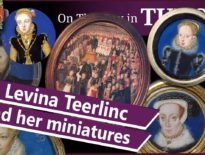On this day in Tudor history, 24th June 1532, the feast of St John the Baptist, Robert Dudley, Earl of Leicester and favourite of Elizabeth I, was born.
Elizabeth I called Leicester her "eyes" and "sweet Robin" and there was gossip over their relationship, but there was far more to Robert Dudley than his closeness to the queen. Find out all about his life and career in today's talk:
Also on this day in history, 24th June 1509, seventeen-year-old King Henry VIII and his queen consort, Catherine of Aragon, were crowned king and queen at a joint coronation ceremony at Westminster Abbey. You can find out more about their coronation in last year’s video:
And today is also the Feast of St John the Baptist and Midsummer. I explain how this was celebrated in Tudor times in this special video:
Robert Dudley’s death and His Last Letter:
Also on this day in history:
- 1513 – Death of Sir Edmund Carew, administrator and soldier. Carew was killed at Thérouanne in Artois when the town was under siege by English troops. He was there as Master of the Ordnance. He was buried in the church of St Nicholas at Calais two days later.
- 1604 – Death of Edward de Vere, 17th Earl of Oxford, courtier and poet. He was buried in the graveyard of the church of St Augustine, Hackney. Oxfordians believe that de Vere was actually the author of Shakespeare's works, and some people go as far as saying that de Vere was the son of Elizabeth I by Thomas Seymour.
Transcript:
On this day in Tudor history, 24th June 1532, the feast of St John the Baptist, Robert Dudley, Earl of Leicester and favourite of Elizabeth I, was born.
The following overview of Robert Dudley’s life is based on an article I wrote for the Tudor Society a few years ago.
Robert Dudley, Earl of Leicester was the fifth son of John Dudley, Duke of Northumberland, and his wife, Jane Guildford. Robert received a humanist education and his tutors included the likes of John Dee, Thomas Wilson, Roger Ascham, and Robert’s uncle, Sir Francis Jobson, and he was brought up as a Protestant. He could write and speak Italian fluently, had knowledge of French and Latin, and had a keen interest in navigation, engineering and mathematics. He married Amy Robsart, his sweetheart, on the 4th June 1550 in the presence of King Edward VI.
In July 1553, on the death of Edward VI, Lady Jane Grey, wife of Robert’s brother, Guildford Dudley, became queen but her reign lasted just thirteen days because Mary I seized the throne. Guildford, Jane and Robert's father, John Dudley, were later executed. Robert was imprisoned and condemned to death, but was fortunately released in autumn 1554. He served Mary I fighting in the Battle of St Quentin in August 1557.
Robert became Elizabeth I’s Master of the Horse shortly after her accession in November 1558, and was elected a Knight of the Garter in April 1559. It was rumoured that he and the queen, whom he’d known since childhood, were more than friends and there was a scandal when Robert's wife, Amy, died in September 1560. There is still debate today over the nature of Elizabeth and Robert’s relationship.
Elizabeth called Robert her “Eyes” and “Sweet Robin”, and spoke of making him the “Protector of the Realm” when she believed she was dying from smallpox in October 1562. He went on to serve her as a privy councillor. In 1563, Elizabeth put forward the idea that Robert should marry Mary, Queen of Scots, but this idea came to nothing.
Robert was granted Kenilworth Castle in Warwickshire in June 1563 and he famously improved it for the queen's visit in 1575, adding a gatehouse, luxury apartments and a beautiful garden. He also held a lavish celebration there which lasted over two weeks and which is seen as a last-ditch attempt to win the queen's hand in marriage. It didn’t work.
Robert was descended, on his father's side, from Richard Beauchamp, Earl of Warwick, and so adopted the Bear and Ragged Staff heraldic device of the Earls of Warwick.
Robert had an illegitimate son, Robert Dudley, from his relationship with Lady Douglas Sheffield. This Robert Dudley (1574-1649) became a well-known explorer and cartographer, leading an expedition to the West Indies in 1594.
Robert secretly married Lettice Knollys, daughter of the queen's cousin, Catherine Carey, and Sir Francis Knollys, and widow of Walter Devereux, on 21st September 1578. The queen was furious when she found out and she referred to Lettice as “the she-wolf”. In 1581, Robert and Lettice had a son, Robert Dudley, Lord Denbigh, who was known as “the noble impe”, but he died in 1584 and was buried in the Collegiate Church of St Mary, in Warwick.
Robert Dudley founded Lord Leycester’s Hospital in Warwick in 1571 and this beautiful Tudor building can still be seen in Warwick today. He was made commander of the English forces in the Netherlands in 1585 and when the Spanish Armada threatened England in 1588, Robert was in charge of mustering the English land forces as Lieutenant and Captain General of the Queen’s Armies and Companies, and was responsible for Elizabeth’s famous visit to Tilbury, where she gave her famous Tilbury speech.
Robert supported the execution of Mary Queen of Scots in 1587 and financially supported Sir Francis Drake’s circumnavigation of the world.
He was chancellor of the University of Oxford and was a known patron of the Arts, being interested in theatre, literature and history. He had his own company of players and was the patron of the artist and miniaturist Nicholas Hilliard.
Robert Dudley, Earl of Leicester, died at Cornbury Park near Oxford on 4th September 1588 on his way to take the waters at Buxton for his health. Elizabeth I was distraught at the news of Robert’s death and locked herself away for days. She kept the last letter he wrote to her shortly before his death, keeping it in a box beside her bed and writing on it “His Last Letter”. I’ll give you a link to my video on his death and His Last Letter.
Robert Dudley was buried at the Collegiate Church of St Mary in Warwick and shares a tomb there with his wife, Lettice, who died in 1634. His brother, Ambrose Dudley, Earl of Warwick, is also buried there.



Leave a Reply